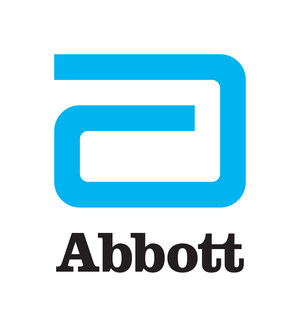Abbott Completes Enrollment of Absorb™ Randomized Clinical Trials in the United States, Japan and China
- First-of-its-Kind Dissolving Medical Device Being Evaluated in People with Blocked Heart Vessels
- Comprehensive Clinical Trial Program Demonstrates Abbott's Global Leadership in Bioresorbable Vascular Scaffold Technology
- Enrollment Completions Mark Significant Progress Toward Bringing Absorb to Countries Representing More Than 50 Percent of the World's Heart Stent Market
ABBOTT PARK, Ill., April 10, 2014 /PRNewswire/ -- Abbott (NYSE: ABT) today announced it has completed enrollment of three clinical trials to support approvals of the company's revolutionary Absorb™ Bioresorbable Vascular Scaffold (BVS) in the United States, Japan and China. Combined, the U.S., Japan and China account for more than 50 percent of the world's heart stent market. Abbott leads the market in developing and commercializing a drug eluting BVS for blocked heart vessels. Absorb received CE Mark in 2011 and is available in more than 60 countries around the world.
"The randomized clinical trials for Absorb demonstrate Abbott's commitment to provide the highest level of clinical evidence possible to assess Absorb compared to metallic drug eluting stents – the current standard of care," said Charles A. Simonton, M.D., FACC, FSCAI, divisional vice president, Medical Affairs, and chief medical officer, Abbott Vascular. "We look forward to evaluating the results of these trials, which we intend to submit to support regulatory approvals of the device."
Absorb works by opening a blocked vessel and restoring blood flow to the heart similar to a metallic stent; however, unlike a metallic stent, Absorb dissolves over time, potentially leaving behind a more flexible vessel because it is free from a permanent metallic stent which cages the vessel.1, 2 Absorb is referred to as a scaffold to indicate that it is a temporary structure, unlike a metallic stent, which is a permanent implant. Absorb is made of polylactide, a naturally dissolvable material that is commonly used in medical implants such as dissolving sutures.
The ABSORB III clinical trial, which enrolled approximately 2,000 people in the United States, will evaluate the potential benefits of Absorb in people with coronary artery disease, a narrowing of one or more arteries that supply blood to the heart. The primary endpoint of ABSORB III is target lesion failure (TLF), a combined measure of the safety and effectiveness of Absorb in comparison to the company's XIENCE family of drug eluting stents at one year.
"The rapid completion of enrollment in the Absorb randomized trials is a testament to the interest among doctors and patients in advancing new options to treat heart disease," said Gregg Stone, M.D., FACC, FSCAI, director, cardiovascular research and education, Center for Interventional Vascular Therapy, Columbia University Medical Center, New York-Presbyterian Hospital. "Absorb represents an entirely new approach to helping people with heart disease by doing the job of a metallic stent, but then disappearing after its work is done, giving people the opportunity to live their lives free of a permanent metallic device implanted in their arteries."
The ABSORB Japan and ABSORB China trials enrolled approximately 400 people each, and the primary endpoint is TLF at one year and late loss at one year, respectively, in comparison to the XIENCE family of drug eluting stents. The ABSORB II trial enrolled approximately 500 people, mostly in Europe, and one-year clinical results are anticipated later this year.
"The medical community eagerly awaits the results of the randomized trials for Absorb," said Dean Kereiakes, M.D., FACC, FSCAI, medical director of The Christ Hospital Heart & Vascular Center and the Lindner Research Center in Cincinnati, and professor of clinical medicine at Ohio State University. "We have made tremendous progress in interventional cardiology with the advances in metallic stents. A device that could provide similar benefits but not leave behind a permanent implant has the potential to transform the way coronary artery disease is treated."
About the Absorb Bioresorbable Vascular Scaffold
Abbott's BVS delivers everolimus, an anti-proliferative drug used in Abbott's XIENCE coronary stent systems. Everolimus was developed by Novartis Pharma AG and is licensed to Abbott by Novartis for use on its drug eluting vascular devices. Everolimus has been shown to inhibit in-stent neointimal growth in the coronary vessels following stent or scaffold implantation.
Absorb is an investigational device, limited by United States law to investigational use and is not approved or available for sale in the United States. Absorb is authorized for sale in CE Mark countries. Absorb is available in Europe, the Middle East, parts of Latin America, and parts of Asia Pacific, including India.
About Abbott Vascular
Abbott Vascular is the world's leader in drug eluting stents. Abbott Vascular has an industry-leading pipeline and a comprehensive portfolio of market-leading products for cardiac and vascular care, including products for coronary artery disease, vessel closure, endovascular disease and structural heart disease.
About Abbott
Abbott is a global healthcare company devoted to improving life through the development of products and technologies that span the breadth of healthcare. With a portfolio of leading, science-based offerings in diagnostics, medical devices, nutritionals and branded generic pharmaceuticals, Abbott serves people in more than 150 countries and employs approximately 69,000 people.
Visit Abbott at www.abbott.com and connect with us on Twitter at @AbbottNews.
| 1 Absorb completely dissolves except for two pairs of tiny metallic markers, which help guide placement and remain in the artery to enable a physician to see where the device was placed. |
| 2 Preliminary evidence suggests that natural vessel function is possible and may improve long term outcomes. Absorb is a trademark of the Abbott Group of Companies. |
SOURCE Abbott
WANT YOUR COMPANY'S NEWS FEATURED ON PRNEWSWIRE.COM?
Newsrooms &
Influencers
Digital Media
Outlets
Journalists
Opted In





Share this article